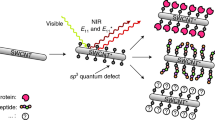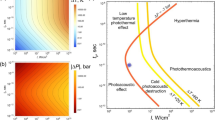Abstract
Biomedical applications of carbon nanotubes have attracted much attention in recent years. Here, we summarize our previously developed protocols for functionalization and bioconjugation of single-walled carbon nanotubes (SWNTs) for various biomedical applications including biological imaging; using nanotubes as Raman, photoluminescence and photoacoustic labels; sensing using nanotubes as Raman tags and drug delivery. Sonication of SWNTs in solutions of phospholipid-polyethylene glycol (PL-PEG) is our most commonly used protocol of SWNT functionalization. Compared with other frequently used covalent strategies, our non-covalent functionalization protocol largely retains the intrinsic optical properties of SWNTs, which are useful in various biological imaging and sensing applications. Functionalized SWNTs are conjugated with targeting ligands, including peptides and antibodies for specific cell labeling in vitro or tumor targeting in vivo. Radio labels are introduced for tracking and imaging of SWNTs in real time in vivo. Moreover, SWNTs can be conjugated with small interfering RNA (siRNA) or loaded with chemotherapy drugs for drug delivery. These procedures take various times ranging from 1 to 5 d.
This is a preview of subscription content, access via your institution
Access options
Subscribe to this journal
Receive 12 print issues and online access
$259.00 per year
only $21.58 per issue
Buy this article
- Purchase on Springer Link
- Instant access to full article PDF
Prices may be subject to local taxes which are calculated during checkout









Similar content being viewed by others
References
Liu, Z., Tabakman, S., Welsher, K. & Dai, H. Carbon nanotubes in biology and medicine: in vitro and in vivo detection, imaging and drug delivery. Nano Res. 2, 85–120 (2009).
Bianco, A., Kostarelos, K., Partidos, C.D. & Prato, M. Biomedical applications of functionalised carbon nanotubes. Chem. Commun. 571–577 (2005).
Kam, N.W.S., Jessop, T.C., Wender, P.A. & Dai, H.J. Nanotube molecular transporters: internalization of carbon nanotube-protein conjugates into mammalian cells. J. Am. Chem. Soc. 126, 6850–6851 (2004).
Liu, Z., Winters, M., Holodniy, M. & Dai, H.J. siRNA delivery into human T cells and primary cells with carbon-nanotube transporters. Angew. Chem. Int. Ed. Engl. 46, 2023–2027 (2007).
Kam, N.W.S., Liu, Z.A. & Dai, H.J. Carbon nanotubes as intracellular transporters for proteins and DNA: an investigation of the uptake mechanism and pathway. Angew. Chem. Int. Ed. Engl. 45, 577–581 (2006).
Kam, N.W.S., Liu, Z. & Dai, H. Functionalization of carbon nanotubes via cleavable disulfide bonds for efficient intracellular delivery of siRNA and potent gene silencing. J. Am. Chem. Soc. 127, 12492–12493 (2005).
Kam, N.W.S. & Dai, H. Carbon nanotubes as intracellular protein transporters: generality and biological functionality. J. Am. Chem. Soc. 127, 6021–6026 (2005).
Sayes, C.M. et al. Functionalization density dependence of single-walled carbon nanotubes cytotoxicity in vitro . Toxicol. Lett. 161, 135–142 (2006).
Liu, Z. et al. Circulation and long-term fate of functionalized, biocompatible single-walled carbon nanotubes in mice probed by Raman spectroscopy. Proc. Natl. Acad. Sci. USA 105, 1410–1415 (2008).
Schipper, M.L. et al. A pilot toxicology study of single-walled carbon nanotubes in a small sample of mice. Nat. Nanotech. 3, 216–221 (2008).
Liu, Z. et al. Drug delivery with carbon nanotubes for in vivo cancer treatment. Cancer Res. 68, 6652–6660 (2008).
Heller, D.A., Baik, S., Eurell, T.E. & Strano, M.S. Single-walled carbon nanotube spectroscopy in live cells: towards long-term labels and optical sensors. Adv. Mater. 17, 2793–2799 (2005).
Leeuw, T.K. et al. Single-walled carbon nanotubes in the intact organism: near-IR imaging and biocompatibility studies in Drosophila. Nano Lett. 7, 2650–2654 (2007).
Chen, Z. et al. Protein microarrays with carbon nanotubes as multicolor Raman labels. Nat. Biotechnol. 26, 1285–1292 (2008).
Liu, Z. et al. Multiplexed multi-color Raman imaging of live cells with isotopically modified single walled carbon nanotubes. J. Am. Chem. Soc. 130, 13540–13541 (2008).
Welsher, K., Liu, Z., Daranciang, D. & Dai, H. Selective probing and imaging of cells with single walled carbon nanotubes as near-infrared fluorescent molecules. Nano Lett. 8, 586–590 (2008).
de la Zerda, L . et al. Photoacoustic molecular imaging in living mice utilizing targeted carbon nanotubes. Nat. Nanotechnol. 3, 557–562 (2008).
Zavaleta, C. et al. Noninvasive Raman spectroscopy in living mice for evaluation of tumor targeting with carbon nanotubes. Nano Lett. 8, 2800–2805 (2008).
Qian, X.M. et al. In vivo tumor targeting and spectroscopic detection with surface-enhanced Raman nanoparticle tags. Nat. Biotechnol. 26, 83–90 (2008).
Alivisatos, A.P., Gu, W.W. & Larabell, C. Quantum dots as cellular probes. Ann. Rev. Biomed. Eng. 7, 55–76 (2005).
Liu, Z., Sun, X., Nakayama, N. & Dai, H. Supramolecular chemistry on water-soluble carbon nanotubes for drug loading and delivery. ACS Nano 1, 50–56 (2007).
Kam, N.W.S., O'Connell, M., Wisdom, J.A. & Dai, H. Carbon nanotubes as multifunctional biological transporters and near-infrared agents for selective cancer cell destruction. Proc. Natl. Acad. Sci. USA 102, 11600–11605 (2005).
Chakravarty, P. et al. Thermal ablation of tumor cells with anti body-functionalized single-walled carbon nanotubes. Proc. Natl. Acad. Sci. USA 105, 8697–8702 (2008).
Zhang, Z.H. et al. Delivery of telomerase reverse transcriptase small interfering RNA in complex with positively charged single-walled carbon nanotubes suppresses tumor growth. Clin. Cancer Res. 12, 4933–4939 (2006).
Liu, Z. et al. In vivo biodistribution and highly efficient tumour targeting of carbon nanotubes in mice. Nat. Nanotechnol. 2, 47–52 (2007).
Niyogi, S. et al. Chemistry of single-walled carbon nanotubes. Acc. Chem. Res. 35, 1105–1113 (2002).
Rosca, I.D., Watari, F., Uo, M. & Akaska, T. Oxidation of multiwalled carbon nanotubes by nitric acid. Carbon 43, 3124–3131 (2005).
Tagmatarchis, N. & Prato, M. Functionalization of carbon nanotubes via 1,3-dipolar cycloadditions. J. Mater. Chem. 14, 437–439 (2004).
Liu, Y. et al. Polyethylenimine-grafted multiwalled carbon nanotubes for secure noncovalent immobilization and efficient delivery of DNA. Angew. Chem. Int. Ed. Engl. 44, 4782–4785 (2005).
Ross, J.S. & Fletcher, J.A. The HER-2/neu oncogene in breast cancer: prognostic factor, predictive factor, and target for therapy. Stem Cells 16, 413–428 (1998).
Jin, H. & Varner, J. Integrins: roles in cancer development and as treatment targets. Br. J. Cancer 90, 561–565 (2004).
Cai, W.B. & Chen, X.Y. Preparation of peptide-conjugated quantum dots for tumor vasculature-targeted imaging. Nat. Protoc. 3, 89–96 (2008).
Anderson, J., Banerjea, A., Planelles, V. & Akkina, R. Potent suppression of HIV type 1 infection by a short hairpin anti-CXCR4 siRNA. AIDS Res. Hum. Retroviruses 19, 699–706 (2003).
Novina, C.D. et al. siRNA-directed inhibition of HIV-1 infection. Nat. Med. 8, 681–686 (2002).
Acknowledgements
The multiple projects involved here were supported by a Stanford Graduate Fellowship, a Stanford Bio-X grant, CCNE-TR at Stanford University, NIH-NCI R01 CA135109-02 and Ensysce Biosciences Inc. Drs Nadine Wong Shi Kam, Sarunya Bangsaruntip, Xiaowu Tang, Xiaoming Sun, Xiaoyuan Chen, Weibo Cai and Ms Nozomi Nakayama have also contributed in the development of this protocol.
Author information
Authors and Affiliations
Contributions
Z.L. and H.D. designed and wrote this paper. S.M.T. and Z.C. revised the paper.
Corresponding authors
Rights and permissions
About this article
Cite this article
Liu, Z., Tabakman, S., Chen, Z. et al. Preparation of carbon nanotube bioconjugates for biomedical applications. Nat Protoc 4, 1372–1381 (2009). https://doi.org/10.1038/nprot.2009.146
Published:
Issue Date:
DOI: https://doi.org/10.1038/nprot.2009.146
This article is cited by
-
Potentialities of Bio-functionalized Carbon Nanotubes for Different Anti-cancerous Activities
Journal of Inorganic and Organometallic Polymers and Materials (2024)
-
Carbon nanotube uptake in cyanobacteria for near-infrared imaging and enhanced bioelectricity generation in living photovoltaics
Nature Nanotechnology (2022)
-
Inheritable nanotubes boost bioimaging and photovoltaics in cyanobacteria
Nature Nanotechnology (2022)
-
Quantum defects as versatile anchors for carbon nanotube functionalization
Nature Protocols (2022)
Comments
By submitting a comment you agree to abide by our Terms and Community Guidelines. If you find something abusive or that does not comply with our terms or guidelines please flag it as inappropriate.



